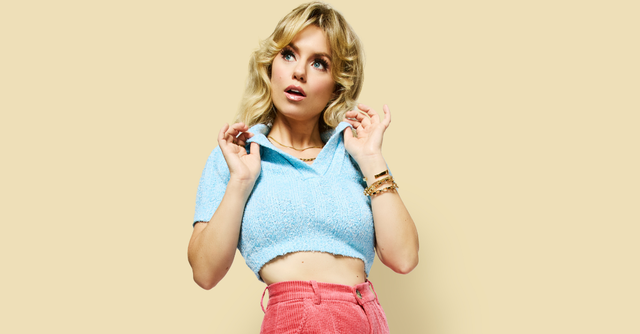From performing off-Broadway, to Cirque Du Soleil, to Scary Pockets, Therese Curatolo is not your average performer. Whether it’s from her distinct style or her infectious hooks, Curatolo might just be one of the coolest artists to come up on the scene yet. I had the pleasure of getting to know and learn more about Curatolo’s creative process, her art direction, and more.
Tell me about the process of making “Braille.”
“Braille” actually popped into my head while I was on tour last year and I had to jot it down. I wrote all of the lyrics and all of the words down on my flight back to the states. It was the first project I started at the beginning of quarantine last year with my brother, Paul. I went back home to Reno-Tahoe and I played him [my song] and he goes, “That’s cute.” He knew immediately that he wanted to produce it in the funk style. When I pitched the song to my dear friend Kate Aldean, who directed the video, she heard the colors, style, the entire video. She coined the phrase “Big Crush Energy,” and that’s how the concept of the video came about.
In regards to “Tokyo” and “L.A. Struggle,” did you have a similar creative process for those songs?
Funny story about “Tokyo,” I was in Tokyo when “Braille” popped into my head. When I came home from Tokyo, that was the last show that we performed. I was out on the road with a funk group called Scary Pockets, so that was fresh on the brain. That song was a happy accident. One of my producers, Allen Lewis, came to me with a skeletal track of just a few chords. That song just organically fell out of me. [For the concept of that video], my good friend and I knew that we were in quarantine and we couldn’t do anything. This was last September, right at the height of lockdown. So that was our makeshift video that we used to project images of Tokyo and Japan.
With “L.A. Struggle,” my other friend Chris helped me put it together and that was just a compilation of me performing around Los Angeles. It’s just a matter of moving forward. We’re all fighting the same fight, and you just have to keep your head up and keep moving forward in your business. It’s all gonna be okay.
How would you describe your overall creative process?
I want to say that it’s structured, but it’s really not. When an idea or thought comes to me, I just take it and I make something from it. That’s how I look at songwriting and my craft. When inspiration strikes and constructs out of nowhere, you just never know.
So speaking of Scary Pockets and Postmodern Jukebox, how did you start working with them?
It’s funny, it was almost like I was peer-pressured into submitting a video to Scott Bradley’s Postmodern Jukebox Star Search. We had so many mutual friends that I was like, “You know what? Why not?” That was back in 2018, and I submitted a video to him and he reached out and we started working together. From there, within the Postmodern Jukebox world and Scary Pockets world, the singers merge a lot. They’re two different flavors but at the end of the day, it’s still music and it’s a great outlet for vocalists.
My friend Jasmine actually went behind my back and reached out to Scary Pockets and said, “Hey, you should work with my friend, Therese.” The rest was history.
Noticing the aesthetics that you use for videos such as “Braille,” “Babe,” “Tokyo,” etc., what about those styles are you so drawn to?
I consider myself an old soul in the modern generation. I love all things retrospective. I grew up in an old-school household and we were always listening to oldies. I really cling to the 80s and everything about [the] 70s, 60s, 50s, and 40s. I just want to take my viewers and listeners back in time; I think it’s so fun. Yeah, we’re saturated in everything that’s modern, but sometimes when we recycle something that we have not heard or seen in a minute, it feels so fresh. I love that retrospective aspect of my art.
What is the direction that you want to go with your music?
I have this backlog of material and songs. Right now, [we’re] just having a lot of fun experimenting with different sounds and genre styles. We’re not really latching on to one specific sound, just trying to keep it fresh. That’s why every single that comes out, no two sound alike, with the exception of “Babe” and “Tokyo.” It’s like one big quilt of music and we’re gauging what the listener likes.
So you’ve performed off-Broadway and even in Cirque Du Soleil, and you also have performed in smaller, more intimate venues as well. Which setting do you personally prefer?
As much as I love the amphitheater and huge crowds, my favorite are the intimate settings where everyone is in the standing rooms and you can actually crowd surf. You feel more connected to the audience that way.
If you were to leave a legacy behind, how would you want to be remembered?
I would love to be remembered as authentic and kind. Nobody is you and that is your superpower. I would never want to be anybody else. I just want everybody to stand tall in their authenticity.
You can listen to “Braille” below.
Photos and Videos Courtesy of Therese Curatolo
More from BUST
Ora The Molecule Is Creating A Safe Place For Self Expression: BUST Interview
Heather Youmans Wants To Help You Get “A Little Closer To Happy” With Her Newest Single
Julien Baker Is Bold and Confident In Arena-Worthy Album “Little Oblivions”






